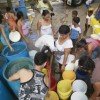(LAHT) After the worst downpours Panama has seen in the last 200 years, close to a million inhabitants of the capital have their water rationed and, for the first time in decades, cannot drink it directly because of contamination.
The complicated situation has no short-term solution, Panamanian Health Minister Franklin Vergara told reporters Saturday, adding that the latest analyses of 56 samples of water from the chief purification facility in the capital show no presence of bacteria.
However, “because of the dense cloudiness of the water at the purification plant, the Health Ministry again warns members of the public that the water is not suitable for consumption,” the minister said.
The director of water purification plants, Rodrigo Barragan, cited by the local daily La Prensa, said that viscosity at one point was 3,500 percent higher than what is permissible, but has currently dropped to 174 Nephelometric Turbidity Units, or NTU, the unit of for measuring cloudiness and lack of transparency, so that it is still not suitable for direct consumption, for which purpose it must register no higher than 10 NTU.
The water supply in the capital is normally 0.5 NTU.
The storm last Dec. 8 was far worse than forecast because of a cold front coming from Colombia that caused flooding and left 10 people dead, more than 15,000 affected and an immense amount of material damage, still not quantified, in the central and eastern parts of the country.
The administrator of the Panama Canal authority, or ACP, Alberto Aleman Zubieta, told a recent press conference that the downpours filled the lakes that supply the Panama Canal and made it necessary for the sluicegates of the dams to be opened that also supply the Chilibre water purification plant, which in turn provides potable water for Panama City and its surrounding area.
He said that rains of such intensity fall in Panama once every 200 years, according to historical records of the ACP.
The unprecedented power of the flooding washed thousands of tons of dirt from the banks of Lakes Gatun and Alhajuela, affected for decades by deforestation, which increased the turbidity level 100 times, a level that the Chilibre water purification plant was not equipped to handle.
Residents of the Panamanian capital, where social networks are steaming with anger at the situation, have stopped drinking the water directly that they previously boasted was the “purest in the world,” and have become resigned to buying bottled water, and consequently to dealing with speculation and scarcity.
This Saturday the IDAAN water and sewers institute sent out 95 tanker trucks to supply hospitals, prisons, the international airport at Tocumen and the city’s upper altitudes, while every day it announces which areas that are not receiving water through the system and broadcasts radio messages asking the public not to drink the water unless it has been strained and boiled.
Of the 135 million gallons a day that the Chilibre water purification plant should process for almost 1 million people, it is currently achieving about 75 percent, but news of another cold front on the way, perhaps starting Sunday, has the public alarmed once more.